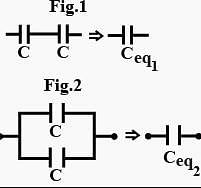Physics: Topic-wise Test- 4 - NEET MCQ
30 Questions MCQ Test NEET Mock Test Series 2025 - Physics: Topic-wise Test- 4
Mid way between the two equal and similar charges, we placed the third equal and similar charge. Which of the following statements is correct, concerned to the equilibrium along the line joining the charges ?
| 1 Crore+ students have signed up on EduRev. Have you? Download the App |
Select the correct statement : (Only force on a particle is due to electric field)
Consider a conductor with a spherical cavity in it. A point charge q0 is placed at the centre of cavity and a point charge Q is placed outside conductor.
Statement-1 : Total charge induced on cavity wall is equal and opposite to the charge inside.
Statement-2 : If cavity is surrounded by a Gaussian surface, where all parts of Gaussian surface are
located inside the conductor,

The figure shows a nonconducting ring which has positive and negative charge non uniformly distributed on it such that the total charge is zero. Which of the following statements is true ?

If we use permittivity e, resistance R, gravitational constant G and voltage V as fundamental physical quantities, then -
A particle of mass m and charge q is thrown in a region where uniform gravitational field and electric field are present. The path of particle
Statement - 1 : A positive point charge initially at rest in a uniform electric field starts moving along electric lines of forces. (Neglect all other forces except electric forces)
Statement - 2 : Electric lines of force represents path of charged particle which is released from rest in it.
Two small balls, each having equal positive charge Q are suspended by two insulating strings of equal length L from a hook fixed to a stand. If the whole set-up is transferred to a satellite in orbit around the earth,the tension in each string is equal to

An electric dipole is placed at an angle of 30o to a non-uniform electric field. The dipole will experience
Two point charges +8q and –2q are located at x = 0 and x = L respectively. The location of a point onthe x axis at which the net electric field due to these two point charges is zero is:
Here is a combination of three identical capacitors. If resultant capacitance is 1 μƒ, calculate capacitance of each capacitor.

If the potential difference of a 6µF capacitor is changed from 10V to 20V, the increase in energy stored will be
If two spheres of different radii have equal charge, then the potential will be
The capacitor preferred for high-frequency circuit is
Three different capacitors are connected in series, then:
Calculate the equivalent capacitance for the following combination between points A and B

There are three capacitors with equal capacitance. In series combination, they have a net capacitance of C1 and in parallel combination, a net capacitance of C2.What will be the value of C1 C2?
Two capacitors of 20 μƒ and 30 μƒ are connected in series to a battery of 40V. Calculate charge on each capacitor.
Two capacitors of equal capacity are first connected in series and then in parallel. The ratio of the total capacities in the two cases will be
When two capacitors C1 and C2 are connected in series and parallel, their equivalent capacitances comes out to be 3μƒ and 16μƒ respectively. Calculate values of C1 and C2.
Some charge is being given to a conductor. Then its potential:
The value of electric potential throughout the volume of a conductor is
How does the charge densities of conductors vary on an irregularly shaped conductor?
Two conductors having same type of charges are connected by a conducting wire. There would not be any amount of charges on them if:
Four resistances of 3Ω, 3Ω, 3Ω and 4Ω respectively are used to form a Wheatstone bridge. The 4Ω resistance is short circuited with a resistance R in order to get bridge balanced. The value of R will be
Resistances P, Q, S and R are arranged in a cyclic order to form a balanced Wheatstone's network. The ratio of power consumed in the branches (P + Q) and (R + S) is
A simple circuit contains an ideal battery and a resistance R. If a second resistor is placed in parallel with the first.
|
1 videos|26 docs|111 tests
|
|
1 videos|26 docs|111 tests
|




































